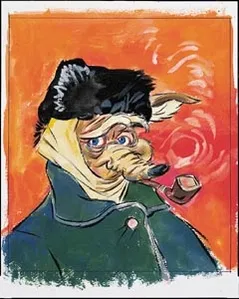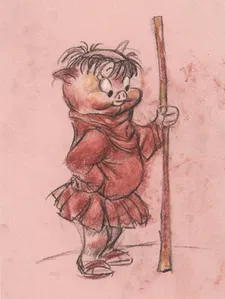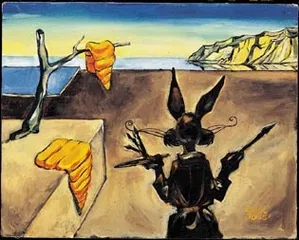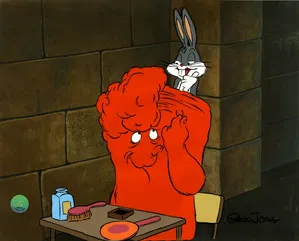Chuck Jones Valentine Season Giclee On Paper
Status: In Stock Available | Condition: New | Edition:Looney Tunes Giclee On Paper | Edition Size: Limited Edition 250 | Dim:11.5 X 15 | Chuck Jones| Item #: CJGICLEE65
Price: $ 675.00 USD.. 🚚 This item ships FREE
12/6/2025 $225.00 1st payment
1/5/2026 $225.00 2nd payment
2/4/2026 $225.00 3rd & final payment
payments are automatically deducted from your credit card.
Optional Payment Methods
As an option you may also pay for Chuck Jones Valentine Season Giclee On Paper using Paypal or with your Amazon Account(*select items). Please note that all orders must be delivered to a physical address verified by Paypal or Amazon.
Shipping Within The Continental USA
Valentine Season Qualifies for Free Shipping
For your peace of mind, every order is shipped fully insured with UPS and requires a signature upon delivery. This ensures that your artwork arrives safely and securely, directly into your hands. Depending on the item, shipments may come from our gallery or from one of our trusted warehouses within the USA.
Before your order is processed and shipped, one of our agents will reach out to you by phone to confirm the details. This extra step ensures everything is accurate, so your artwork arrives smoothly and without any issues. … View our shipping policies
International Shipping
Countries We Ship To:
Request your international delivery cost for items not eligible for PayPal flat rate or free international shipping. Click the link and provide your details to request your quote. We’ll provide your personalized shipping and insurance quote within 24 hours.
Spanish (Español) Solicite el costo de entrega internacional para artículos que no sean elegibles para la tarifa plana de PayPal ni el envío internacional gratuito. Haga clic en el enlace y proporcione sus datos para solicitar su cotización. Le enviaremos su cotización personalizada de envío y seguro en un plazo de 24 horas.
French (Français) Demandez le coût de livraison internationale pour les articles non éligibles au tarif forfaitaire PayPal ou à la livraison internationale gratuite. Cliquez sur le lien et indiquez vos informations pour demander votre devis. Nous vous fournirons un devis personnalisé pour l’expédition et l’assurance sous 24 heures.
German (Deutsch) Fordern Sie die internationalen Lieferkosten für Artikel an, die nicht für den PayPal-Pauschaltarif oder den kostenlosen internationalen Versand berechtigt sind. Klicken Sie auf den Link und geben Sie Ihre Daten ein, um Ihr Angebot anzufordern. Innerhalb von 24 Stunden erhalten Sie Ihr persönliches Angebot für Versand und Versicherung.
Italian (Italiano) Richieda il costo di consegna internazionale per gli articoli non idonei alla tariffa flat di PayPal o alla spedizione internazionale gratuita. Clicchi sul link e inserisca i suoi dati per richiedere il preventivo. Le forniremo un preventivo personalizzato per spedizione e assicurazione entro 24 ore.
Dutch (Nederlands) Vraag de internationale verzendkosten aan voor artikelen die niet in aanmerking komen voor het PayPal-vast tarief of gratis internationale verzending. Klik op de link en geef uw gegevens door om uw offerte aan te vragen. U ontvangt binnen 24 uur een persoonlijke offerte voor verzending en verzekering.
Japanese (日本語) PayPal の定額送料や国際無料配送の対象外となる商品の国際配送料をお見積もりします。リンクをクリックし、必要事項をご入力のうえお見積りをご依頼ください。24時間以内に発送および保険の個別見積りをご案内します。
🇦🇺 🇦🇹 🇩🇰 🇫🇮 🇫🇷 🇩🇪 🇮🇪 🇮🇹 🇯🇵 🇳🇱 🇳🇴 🇪🇸 🇸🇪 🇨🇭 🇬🇧
Promotions For Chuck Jones - Valentine Season
Price Match
Art Terminologies
Giclée - A computerized reproduction technique in which the image and topography are generated from a digital file and printed by a special ink jet printer, using ink, acrylic or oil paints. Giclée printing offers one of the highest degree of accuracy and richness of color available in any reproduction techniques
Lithography - Printing technique using a planographic process in which prints are pulled on a special press from a flat stone or metal surface that has been chemically sensitized so that ink sticks only to the design areas and is repelled by the non-image areas. Lithography was invented in 1798 in Germany by Alois Senefelder.
Serigraphy (Silk-screen) - A printing technique that makes use of a squeegee to force ink directly onto a piece of paper or canvas through a stencil creating an image on a screen of silk or other fine fabric with an impermeable substance. Serigraphy differs from most other printing in that its color areas are paint films rather than printing ink stains.
Remarque – Additional enhancements by the artist on some or all of the final prints within an edition
Artist's Proof (AP) - Print intended for the artist's personal use. It is common practice to reserve approximately ten percent of an edition as artist's proofs, although this figure can be higher. The artist's proof is sometimes referred to by its French épreuve d'artist (abbreviation E.A.). Artist's proofs can be distinguished by the abbreviation AP or E.A., commonly on the lower left of the work.
“Gallery wrapped” is a way of finishing a canvas artwork so it’s ready to hang without needing an additional frame. The canvas is stretched tightly over thick wooden stretcher bars, and the edges of the canvas are wrapped around the sides and stapled on the back.
Stretched - When a canvas is described as stretched, it means the artwork has been pulled tightly over a wooden frame (called stretcher bars) and secured on the back. This process keeps the canvas flat and smooth, ready to hang on the wall or to be placed inside an outer frame.
Hand Embellished - When an artwork is hand embellished, the artist (or a skilled studio artisan) personally adds paint, texture, or other details by hand on top of the printed or finished piece. This gives each artwork unique highlights and depth, making no two pieces exactly alike — even within the same edition.
… learn more Click here for more Art Terms
Availability
Status: In Stock Available
Gift Cards

Gift Card Purchase
E-Gift Cards from The Collection Shop are the perfect way to gift art enthusiasts. Click below for more details!
Chuck Jones bio
In a career spanning over 60 years, Jones made more than 300 animated films, winning three Oscars as director and in 1996 an honorary Oscar for Lifetime Achievement. Among the many awards and recognitions, one of those most valued was the honorary life membership from the Directors Guild of America. During the Golden Age of animation Jones helped bring to life many of Warner Bros. most famous characters”Bugs Bunny, Daffy Duck, Elmer Fudd and Porky Pig. The list of characters he created himself includes Road Runner, Wile E. Coyote, Marvin Martian, Pepe le Pew, Michigan J. Frog and many others. He also produced, directed and wrote the screenplays for "Dr. Seuss How the Grinch Stole Christmas," a television classic, as well as the feature-length film "The Phantom Tollbooth." In addition, Jones was a prolific artist whose work has been exhibited at galleries and museums worldwide. Jones often recalled a small child who, when told that Jones drew Bugs Bunny, replied: "He doesn t draw Bugs Bunny. He draws pictures of Bugs Bunny." His point was that the child thought of the character as being alive and believable, which was, in Jones belief, the key to true character animation. Born on September 21, 1912 in Spokane, Washington, Jones grew up in Hollywood where he observed the talents of Charlie Chaplin and Buster Keaton and worked occasionally as a child extra in Mac Sennett comedies. After graduating from Chouinard Art Institute in Los Angeles (now California Institute of the Arts) Jones drew pencil portraits for a dollar a piece on Olvera Street. Then, in 1932, he got his first job in the fledgling animation industry as a cel washer for former Disney animator, Ubbe Iwerks. It was at Iwerks Productions that he met Dorothy Webster, to whom he was married in 1932. In 1936 Jones was hired by Friz Freleng as an animator for the Leon Schlesinger Studio (later sold to Warner Bros.). Jones admired and revered Freleng for the rest of his life, saying, "No one except Tex Avery had as perfect a sense of timing as did Friz Freleng." In 1937 his daughter, Linda, was born, and in 1938 he directed his first film, The Night Watchman. He worked with and for directors Tex Avery and Bob Clampett until the early forties when they left the studio, and for the remainder of his years at Warner Bros. he worked in parallel with Directors Freleng and Robert McKimson. He remained at Warner Bros. until the studio was closed in 1962. During those years, sometimes referred to later as the Golden Years of Warner Bros. animation, arguably some of the most enduring cartoons ever made were produced; most of them still enjoying worldwide recognition daily. When Warner Bros. closed, and after a very short stay at the Disney Studios, Jones moved to MGM Studios, where he created new episodes from the Tom and Jerry cartoon series. While there, in addition to The Phantom Tollbooth and Dr. Seuss How the Grinch Stole Christmas, Jones directed the Academy Award winning film, The Dot and the Line. Jones established his own production company, Chuck Jones Enterprises, in 1962 and produced nine half-hour animation films for television including Rudyard Kipling s Rikki Tikki Tavi and The White Seal. After the death of his first wife, Jones met and married the love of his life, Marian Dern, who remained his best friend, lover and companion for the rest of his life. In the late 70s Jones and his daughter, Linda, pioneered a continuing art business featuring limited edition images created by Jones depicting scenes from his most enduring cartoons. He continued to support his daughter s business, generously making appearances, drawings and paintings, in addition to signing countless editions of images, which continue to delight collectors and fans worldwide. One of his films, the Wagnerian mini epic, What s Opera, Doc? was inducted into the National Film Registry for being "among the most culturally, historically and aesthetically significant films of our time." In recent years, Jones work has been honored at film festivals and museums throughout the world, including a one-man retrospective at the Museum of Modern Art in New York City. His autobiography, Chuck Amuck, appeared in 1989, now in its fifth printing. Chuck Reducks, his follow-up to the first book, was published two years later. In 2000, Jones established the Chuck Jones Foundation, designed to recognize, support and inspire continued excellence in art and the art of classic character animation. Plans for the Foundation include scholarships, library resources, touring exhibits, a lecture series and access to film, notes and drawings. Director Peter Bogdanovich once explained the enduring appeal of Jones work: "It remains, like all good fables and only the best art, both timeless and universal." After hearing that Jones had died, a four-year-old child asked her mother, between sobs, "Does this mean the bunny won t be in the barber chair any more?" The answer is, "No, the bunny will be in the barber chair forever."

Chuck Jones Hare Hazard Giclee On Canvas - GICLEE-98CJ
Price: $1,950.00
Layaway with 3 pymts of $650.00

Chuck Jones Vincent Van Coyote Lithograph - LITHO02CJ
Price: $950.00
Layaway with 3 pymts of $316.67

Chuck Jones Porky Pig Animation Giclee On Paper - GC28I14CJ
Price: $350.00
Layaway with 3 pymts of $116.67

Chuck Jones Persistence Of Carrots Lithograph - LITHO36CJ
Price: $1,350.00
Layaway with 3 pymts of $450.00



